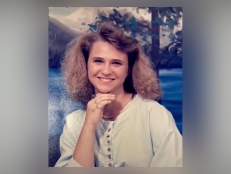Lehigh Valley: Patricia Rorrer — Still A Convenient Suspect?
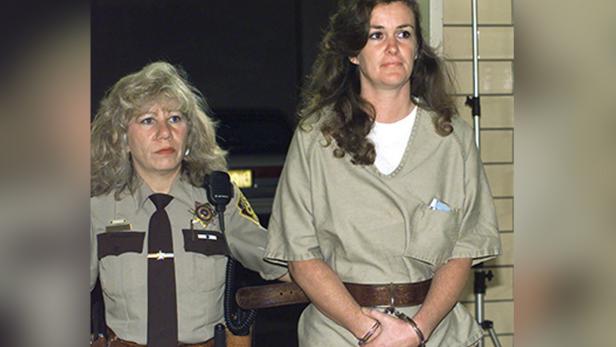
Donna Fisher/Allentown Morning Call/TNS via Getty Image
Patricia Rorrer (right) is led to her hearing in Lehigh County Courthouse Wednesday morning, August 26, 1998 by a sheriff’s deputy, at left.
Back in March of 2017, Investigation Discovery ran Murder in Lehigh Valley: Keith Morrison Investigates which questioned the conviction of Patricia Rorrer for the brutal double murders of Joann Katrinak and her infant son, Alex. Since that time, Rorrer has held out hope that Pennsylvania’s Superior Court would grant her a hearing to examine the new evidence that has come to light in her case. Just recently, however, that hope was dashed when the court denied her appeal.
Keeping a convicted killer in prison on the merits of a case is a good thing, but what about when the courts keep someone incarcerated on completely inaccurate information? You might think such a thing couldn’t happen, but that’s exactly what did happen in the Rorrer case. Contained in Superior Court’s 22-page opinion are a minimum of 24 factual errors; many of which are extremely serious.
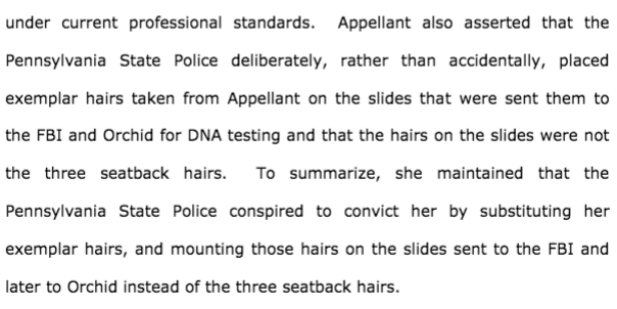
Excerpt from the Superior Court opinion.
You can read the court documents in their entirety here.
Here are just a few examples:
- Superior Court states that all 6 seatback hairs AND the cigarette butt were nuclear DNA tested and matched to Rorrer. This is untrue. To date, the only two pieces of evidence ever nuclear DNA tested in the case were two of the seatback hairs — nothing else.
- Superior Court states that Patricia Rorrer and Andy Katrinak’s romantic relationship ended in May, 1993 — only one year before the murders. This is untrue. Rorrer and Katrinak broke up in 1989 — five years before the murders — and Andy married Joann in May, 1993 after dating for approximately one year.
- Superior Court states that Andy “immediately” called the police on discovering Joann and Alex missing. This is untrue. Andy waited more than 4 ½ hours before phoning the police to report his wife and son missing.
- Superior Court states that evidence was taken from Joann’s “undisturbed” vehicle. This is untrue. Both Andy and Joann’s father admitted to either opening and/or entering the vehicle before the police investigated it.
- Superior Court states that the 3 mounted car hairs were sent to the FBI in July 1995, and Rorrer’s hair samples were taken in November 1995, therefore, since the FBI had possession of the mounted hairs before the Pennsylvania State Police (PSP) took Rorrer’s samples, it is impossible for those hairs to have been switched. This is untrue. The three mounted hairs were not sent to the FBI until one year later, in June of 1996. In fact, the PSP had both the mounted and unmounted hairs, as well as Rorrer’s hair samples in their possession at the same time.
- Superior Court notes that Rorrer’s attorney, Craig Neely, is being paid at “public expense.” This is untrue. Neely has been representing Patricia Rorrer pro-bono all along, and has not received one cent for that representation.
These are but a brief sampling of the many errors and inaccuracies contained in Superior Court’s opinion. How can this happen? How can someone fight it and correct the record? Was it just a mistake that one of the highest courts in the Commonwealth of Pennsylvania got everything so wrong? Or is Patricia Rorrer still just “a convenient suspect”?

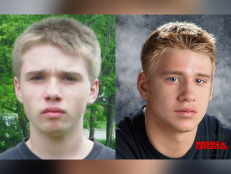


![Elizabeth Gill at two years old [left]; Elizabeth Gill age progressed to 59 years old. She is a white female and has brown hair and blue eyes.](http://investigationdiscovery.sndimg.com/content/dam/images/investigationdiscovery/crimefeed/legacy/2022/07/ncmec-elizabeth-gill-07262022.png.rend.hgtvcom.231.174.suffix/1658848306574.png)
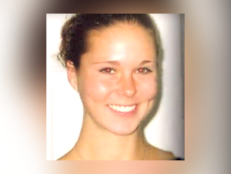

![Lenoria Jones pictured at 3 years old [left]; Lenoria's photo is shown age-progressed to 16 years [right].](http://investigationdiscovery.sndimg.com/content/dam/images/investigationdiscovery/crimefeed/legacy/2023/03/ncmec-lenoria-jones-31723.png.rend.hgtvcom.231.174.suffix/1679081557653.png)

